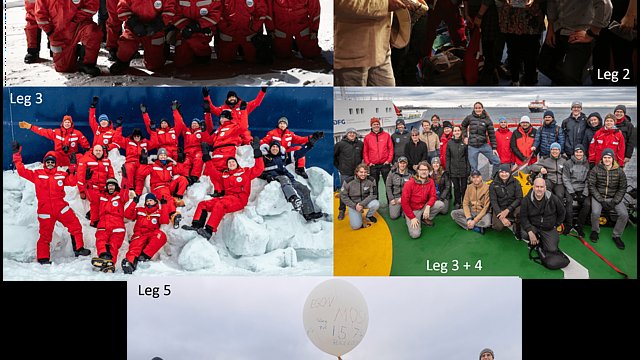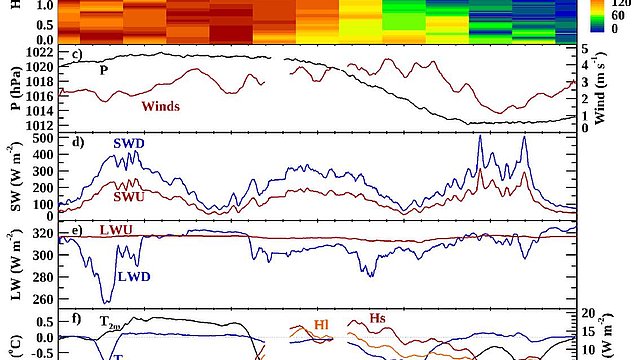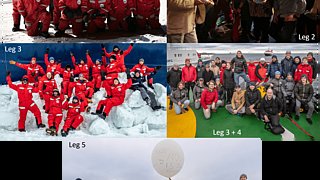The MOSAiC ATMO (Atmosphere)-Team (Figure 1) made observations of relevant atmospheric properties, processes and interactions over an entire annual cycle while drifting across the Central Arctic with the sea ice from October 2019 to September 2020. A broad and diverse international team of scientists designed and implemented a comprehensive programme for observing and characterising all aspects of the Arctic atmospheric system in unprecedented detail. Figure 2 illustrates the key processes that were studied. These included all aspects of the atmosphere’s physical and dynamic structure, clouds and precipitation, gases and aerosols, and energy transfer. Many of the related atmospheric processes are closely linked to ocean and sea-ice processes, and to other components of the highly coupled Arctic system. Ralf Jaiser from the AWI Potsdam comments on the importance of MOSAiC-related research, which extends beyond the Arctic itself: “The Arctic is embedded in the global climate system. A better understanding of Arctic processes improves our ability to make forecasts and projections of the climate system globally.”
A full annual cycle of measurements
While most previous expeditions into the Central Arctic were essentially limited to only a few weeks, the year-long MOSAiC expedition enabled the scientists to study in detail the full annual cycle of atmospheric variability over the Arctic sea ice. Figure 3 shows a time series of selected atmospheric parameters, which details the seasonal transition in the individual parameters, as well as the substantial day-to-day variability, which was primarily due to the short-term impacts of cyclones.
Matthew Shupe from CIRES (University of Colorado and NOAA), atmospheric researcher and co-coordinator of MOSAiC, summarises the overall success of the expedition: “During MOSAiC, we observed more than 20 Arctic cyclones, or storms, of various scales that passed over our ice floe. We have described these events in unprecedented detail, characterising the vertical wind structure and momentum transfer to the sea ice and ocean, which leads to sea-ice movement and fractures. During these events, the impacts of warm air masses moving into the Central Arctic with their associated clouds caused significant shifts in all components of the surface energy balance, affecting the sea-ice temperature, growth, and/or melting. Additionally, year-round information on the variability of atmospheric composition and aerosols provides new insights into the relative influences of long-range transport versus local processes, with important implications for climate-relevant cycles (e.g. the carbon cycle), clouds, and the radiative balance.”
From the surface to the stratosphere
The scientists were interested in the whole atmospheric column above the MOSAiC floe. This meant starting from the millimetre level just over the snow, through the troposphere in a few kilometres elevation, where weather and storm systems propagate, and extending up to the middle stratosphere at roughly 30 km, where the polar vortex is situated during winter. Figure 3 provides a representative data snippet from three days of measurements taken in July 2020. It illustrates the combined and complex effects that dynamics, thermodynamics and cloud processes in the troposphere can have on the temperature, radiative balance and turbulent energy fluxes at the surface. These processes over the Arctic sea ice and their interactions are still only poorly observed and understood. MOSAiC’s comprehensive atmospheric measurement programme will advance our process understanding in this regard.
Complementary measurements for a complex system
A key aspect of the atmospheric measurement programme, but also of the expedition in general, is the complementarity and holistic nature of the measurements, which will enable analyses of processes from manifold perspectives. As an illustrative example, Figure 4 shows vertical profiles of different atmospheric parameters gathered by various instruments during the second day of the July 2020. Throughout the day, temperature profiles were gathered by four complementary measurement systems, revealing a shoaling of the atmospheric boundary layer over time, as can be seen at the top of the cloud layer. Additional instruments provided further information on the relative humidity, clouds and radiative heating, wind and dynamic mixing, aerosol abundance and more.
Nearly one and a half years after the end of the expedition, more and more of the collected raw data is now being analysed and converted into easy-to-use data products for publication, and the teams are thrilled with the initial results. Detailed analyses are now being performed on this basis and will follow in future publications from the corresponding groups.
Step forward for climate modelling
The MOSAiC atmospheric observational data will be fed into a broad range of models in the coming years. The observations will be used to (i) evaluate models via a process-oriented approach, (ii) contribute to an improved Arctic process understanding, (iii) improve models and their parameterisations, and (iv) help advance our ability to understand and predict Arctic climate change. The recently released overview publication by Shupe et al. (2022) offers new perspectives on this research, suggests research questions for future modelling studies, and outlines examples of such activities. Corresponding projects are currently being implemented, including the following highlights: high-resolution large-eddy simulations and process modelling are being used to study small-scale processes concerning clouds, the atmospheric composition and atmospheric boundary layer that were observed in the MOSAiC grid cell. Further studies are designed to evaluate and enhance the predictive capabilities of numerical weather prediction models. For example, a systematic comparison of forecast models at measurement sites has been organised under the auspices of the Year of Polar Prediction (YOPP) and includes the MOSAiC floe. Moreover, the additional atmospheric MOSAiC observations are being used to investigate and advance the forecast reliability of synoptic events in the troposphere-stratosphere system, e.g. in the framework of the SynopSys project, which is funded by the Federal Ministry of Education and Research (BMBF). Last but not least, process-based model evaluations are underway to identify errors in the representation of “fast” processes, such as cloud feedbacks and surface fluxes. These can potentially lead to systematic biases in model-based projections of Arctic climate change, a topic that is now being addressed by the two new EU H2020 projects CRiceS and PolarRES. “Reducing the uncertainties of climate model projections is a major milestone for the upcoming decades, in order to offer support for inevitable decision-making regarding climate change and climate mitigation,” says Annette Rinke from the AWI Potsdam.
References
Shupe, MD, Rex, M, Blomquist, B, Persson, POG, Schmale, J, Uttal, T, Althausen, D, Angot, H, Archer, S, Bariteau, L, Beck, I, Bilberry, J, Bucci, S, Buck, C, Boyer, M, Brasseur, Z, Brooks, IM, Calmer, R, Cassano, J, Castro, V, Chu, D, Costa, D, Cox, CJ, Creamean, J, Crewell, S, Dahlke, S, Damm, E, de Boer, G, Deckelmann, H, Dethloff, K, Dütsch, M, Ebell, K, Ehrlich, A, Ellis, J, Engelmann, R, Fong, AA, Frey, MM, Gallagher, MR, Ganzeveld, L, Gradinger, R, Graeser, J, Greenamyer, V, Griesche, H, Griffiths, S, Hamilton, J, Heinemann, G, Helmig, D, Herber, A, Heuzé, C, Hofer, J, Houchens, T, Howard, D, Inoue, J, Jacobi, H-W, Jaiser, R, Jokinen, T, Jourdan, O, Jozef, G, King, W, Kirchgaessner, A, Klingebiel, M, Krassovski, M, Krumpen, T, Lampert, A, Landing, W, Laurila, T, Lawrence, D, Lonardi, M, Loose, B, Lüpkes, C, Maahn, M, Macke, A, Maslowski, W, Marsay, C, Maturilli, M, Mech, M, Morris, S, Moser, M, Nicolaus, M, Ortega, P, Osborn, J, Pätzold, F, Perovich, DK, Petäjä, T, Pilz, C, Pirazzini, R, Posman, K, Powers, H, Pratt, KA, Preußer, A, Quéléver, L, Radenz, M, Rabe, B, Rinke, A, Sachs, T, Schulz, A, Siebert, H, Silva, T, Solomon, A, Sommerfeld, A, Spreen, G, Stephens, M, Stohl, A, Svensson, G, Uin, J, Viegas, J, Voigt, C, von der Gathen, P, Wehner, B, Welker, JM, Wendisch, M, Werner, M, Xie, ZQ, Yue, F. 2022. Overview of the MOSAiC expedition—Atmosphere. Elementa: Science of the Anthropocene 10(1). DOI: doi.org/10.1525/elementa.2021.00060
Annette Rinke, John J. Cassano, Elizabeth N. Cassano, Ralf Jaiser, Dörthe Handorf; Meteorological conditions during the MOSAiC expedition: Normal or anomalous?. Elementa: Science of the Anthropocene 21 January 2021; 9 (1): 00023. doi: doi.org/10.1525/elementa.2021.00023
Contact
Questions?
Contact us via E-Mail or our contact form.
Graphics











